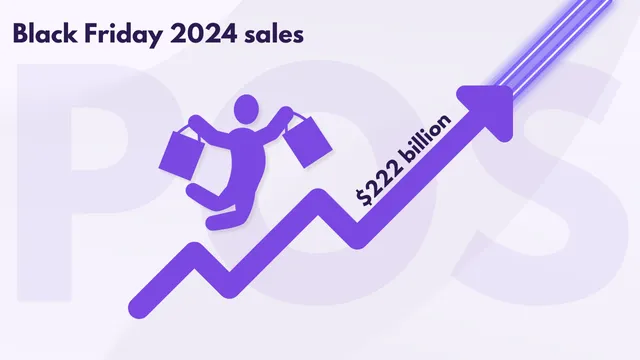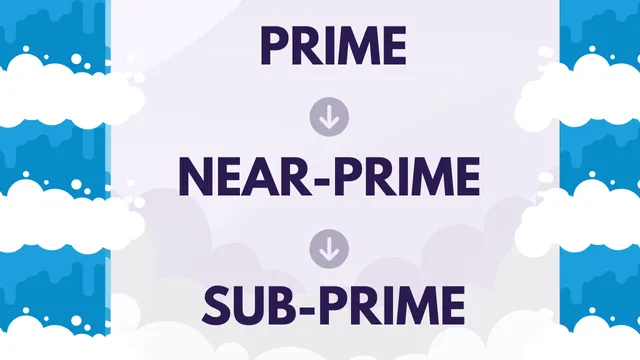Prepare for Black Friday with POS Financing
Merchants are gearing up for Black Friday, which this year falls on November 29. A key focus is meeting the demands of customers opting for omnichannel shopping and alternative payments like point-of-sale (POS) financing. This article explores Black Friday trends and how merchants can enhance the customer experience through POS financing.
Key article takeaways
- Black Friday 2024 sales are projected to surpass $222 billion. Shoppers using POS financing are expected to spend significantly more than buyers using traditional payment methods.
- 78% of merchants recognize POS financing as a strategic priority with enhancing the omnichannel customer experience being a top priority.
- A seamless POS financing solution should integrate effortlessly across all sales channels. Additionally, it should support a broad lending network and leverage waterfall financing to boost approval rates. The platform should simplify management through real-time data and automated processes.
Key 2023 Black Friday statistics
Despite inflationary pressures, Black Friday consumer spending continues to grow. In 2023:
- U.S. retail sales on Black Friday rose by 2.5% year-over-year. This reflects steady consumer demand across both in-store and online channels, (Mastercard).
- U.S. online sales on Black Friday surged to a record-breaking $9.8 billion in 2023. This reflects a 7.5% increase compared to the previous year (PYMNTS).
- In-store Black Friday shopping rose by 1.5% year-over-year. Despite the growth of online sales, most purchases are made in person (Pew Research).
If these trends continue, we can expect even greater synergy between digital and physical retail experiences. Omnichannel strategies will become essential for merchants to capture shoppers whether they are online, in-store, or combining both.
Credit Bloggers Passion
How POS financing is shaping Black Friday
Black Friday’s sales figures provide insights into the nation’s economic trajectory, consumer confidence, and spending patterns. In 2023:
- The average holiday shopper spent approximately $533. Those who opted for POS financing options spent 48% more than shoppers using traditional payment methods (PYMNTS).
- POS financing usage grew by 72% in the week leading up to Black Friday (PYMNTS).
- According to Adobe Analytics, POS financing on Black Friday 2023 saw a 47% increase compared to 2022 (Business Insider)
These trends highlight the growing importance of POS financing to buyers. They also explain why merchants lean towards a waterfall financing model, which offers choice and personalization to customers.

How to implement the best POS financing solution
Despite the rising demand for point-of-sale financing, many retailers still offer fragmented solutions. This results in a disjointed customer experience and complicates management processes. Recognizing the critical role of financing in driving sales, 78% of merchants state that point-of-sale financing is a strategic priority for the next 12 months (ChargeAfter). When upgrading POS lending capabilities, merchants’ top priorities center around the omnichannel customer experience. 40% prioritize improving in-store functionality and 37% aim to optimize the overall customer journey. To achieve this, they need to find a solution that incorporates the following capabilities.
Network of lenders
Shoppers expect unprecedented levels of choice, personalization, and convenience. To achieve comprehensive financing at the point of sale, merchants must offer options from multiple lenders. This allows them to cover the full credit spectrum—prime, near-prime, and no-credit-required—while providing a range of financing products, from installments to revolving credit and lease-to-own, across multiple geographies. Additionally, the broader your lender network, the better protected you are from disruptions caused by changes made by individual lenders.
Waterfall finance capabilities
Waterfall financing is a process where shoppers apply for financing with a single application, and are evaluated according to a tiered system to match them with the best-fit financing choices. First, they are assessed by prime lenders, if they are not approved, their application instantly flows to near-prime lenders, and then to subprime lenders or lease-to-own providers. This happens in real-time and ensures more customers have access to financing, leading to up to 85% approval rates.

Simple management and data processes
Implementing a seamless POS financing solution goes beyond offering diverse payment options—it’s also about simplifying management. Merchants need a solution that integrates effortlessly across in-store, eCommerce, call center, and even in-home environments. Look for platforms that support fast integration with major eCommerce platforms, offer flexible in-store solutions like QR code scanning and self-checkout, and provide API and SDK kits to personalize the online checkout experience.
Additionally, for merchants, real-time updates on financing performance, order information, and customer engagement are essential. A well-designed solution should offer features like automated post-sale management, including dispute resolution, refunds, and reconciliation, as well as data and analytics. This ensures that retailers not only streamline their sales processes but also have direct access to insights that help optimize their financing programs over time.
Want to talk about POS financing?

About Kevin Lawrence
VP Global Lender Relations – Kevin has worked in the banking and finance industry for over a decade. He has worked closely with some of North America’s largest banks, financial institutions, and retailers. Kevin is an expert in embedded consumer financing and B2B financing. He has a deep understanding of current trends and where the industry is heading.